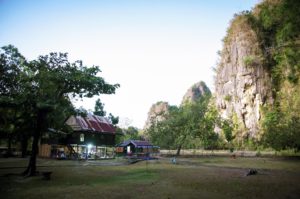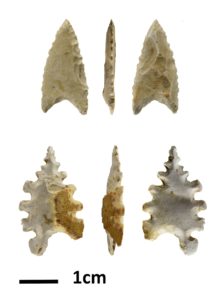New research hasquestionedtheories thatamysteriousgroup of hunter-gatherers fromIndonesia interacted withAboriginal Australians thousands of years ago and providesa basis for future understanding ofthe people who madetiny,but preciseimplements out of stone.

Basecamp at the base of the cave site.
The study, published inPLOS ONE, was led by Griffith University researchers at theAustralian Research Centre for Human Evolutionand Indonesian counterparts from PusatPenelitianArkeologiNasional(PuslitArkenas), whoexaminedacollectionof stone and bone ‘point’ tools made by theToaleanpeopleon the Indonesian island ofSulawesi.
According to the study’s lead author, PhD candidate YinikaPerston, theToaleanswerea group of ‘hunter-gatherer’ people wholived in southernmostSulawesi around 1500-8000 years ago. During this time, they produced several distinctive small toolsthat have not been found elsewhere on the island,including the so-called ‘Marospoints’, which were possibly used as arrowheads and havefinetooth-like serrations.
“Previously, thesetoolshave been fairly inconsistently or even incorrectlydescribed yethave been used to build elaborate scenarios for human activities,”Perstonsaid.
“In our paper,we provide the most complete technological description ofToaleanstone and bone toolsyet. We describeexactly how they weremadeandoutlinenew classification modelsforthe most distinctive forms of stone and bone tools produced in thattime.”

Maros points.
The1739tools were found inknownToaleansites in caves within the limestonekarstthat runs throughMarosandPangkep.
Among these,Perstonandteamreclassified the smallMarospointtools(averaging 25mm long)as four differentvariants— theMarospoint,Mallinrungpoint,Lompoapoint andPangkeppoint.
Working backwardsto examine how the specialised tools were made,Perstonlooked closely at the marksor ‘scars’where other pieces of stone had been removed and where thesescarsoverlapped,to gain a clearer view of what order thepieces of stonewere struckto make the tools, and how.
“There aretheories that thepointswere used for arrowheads or for hunting fish, but we’re hoping that the next stageof research would be tolook attheresidueon the tools so we canfind traces of what theToaleansmight have been using them for,” she said.
“We also describeda new stone tool form,the ‘sawlette’,whichare very similar tocertaintooltypesfromEurope, but this isclearlya case ofculturalconvergence”— that is, unrelated peoplesindependently coming up with broadly similar traits or solutions.”

PhD candidate Yinika Perston.
Perstonsaid the study also laidthe groundwork to assess archaeological scenarios that have been previously proposed, such assimilarities between some of the tools in Australia and Sulawesithatimpliedthat the two regions had contact and exchanged ideasthousands of years ago.
While not ruling out the possibility that ancient Aboriginal communitiesmade contact withpeople outside Australia,the studyindicatesthat the evidence for a connection to theToaleans, at present, is not strong.
“We found that whileMarospoints from Sulawesilook similarto some Australian tools —for example,the famous Kimberley spearheads—the production processes for theToaleanpointsand Australian stone points are actually quite different,and this is a topicwe hope can beexploredfurther,”Perstonsaid.
“Furthermore, the ‘backed microliths’ and the ‘bone points’ that we find inToaleanassemblages are foundin other sitesaround the world. Their presence in Australia mightsimplybedue toconvergence, as is the case with theToaleansawletteswhich clearly have no connection toPalaeolithicEurope.
“We hope this study will be an important tool for archaeologists in Sulawesi, so that future research can be more consistent and reliable.”
The research ‘A standardised classification scheme for the Mid-HoloceneToaleanartefacts of South Sulawesi, Indonesia’ has been published inPLOS ONE.

